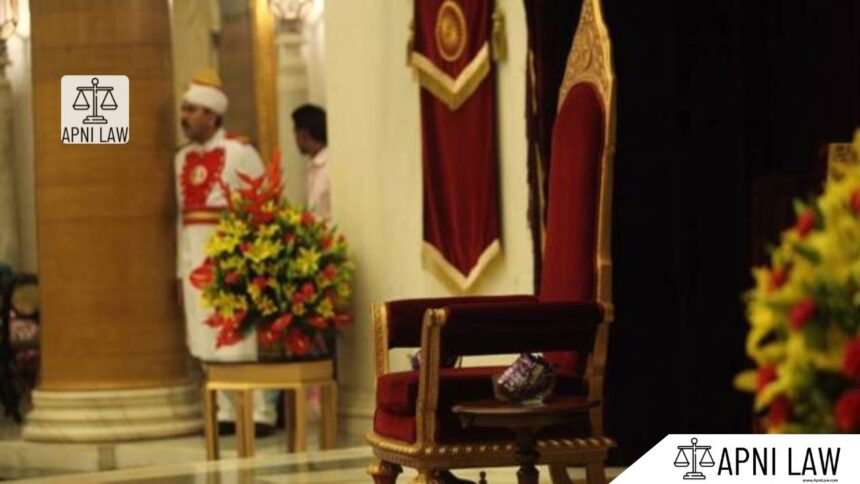This article is written by Atishay Jain, a former UPSC aspirant and a key member of the ApniLaw team, combining his knowledge of the Constitution with a strong interest in public law. For any personal queries or suggestions, feel free to reach out to us through our official channel
What Is Article 356 Of The Indian Constitution Or Process Of Presidents Rule?
- The President can invoke Article 356 if a State government fails to function according to the Constitution.
- This can happen based on the Governor’s report or other information.
- The President may issue a Proclamation to take control of the State’s administration.
- The President can assume all or some functions of the State Government.
- The President can also take over powers of the Governor or any authority in the State, except the State Legislature.
- Parliament can exercise the powers of the State Legislature during this period.
- The President can make additional provisions needed to enforce the Proclamation.
- However, the President cannot take over powers of the High Court or suspend any related provision.
- The Proclamation can be revoked or changed later by another Proclamation.
- The Proclamation must be approved by both Houses of Parliament within two months.
- If not approved, it automatically ends after two months.
- If the Lok Sabha is dissolved during this period, the Rajya Sabha must approve it first.
- Then, the new Lok Sabha must approve it within 30 days of its first session.
- Once approved, the Proclamation remains valid for six months.
- Parliament can extend it every six months through a resolution.
- President’s Rule cannot continue for more than three years.
- For Punjab (Proclamation issued on May 11, 1987), the period extended to five years.
- To continue President’s Rule beyond one year, a national emergency must be in force in the country or that State.
- The Election Commission must also confirm that elections cannot be held due to specific difficulties.
- These conditions did not apply to Punjab’s 1987 Proclamation.
What Are The Grounds for Imposing President’s Rule under Article 356?
The President of India can impose President’s Rule in a State if the government fails to function as per the Constitution. The President may act based on the Governor’s report or independently.
What Is The Criticism of President’s Rule?
- The ruling party at the Centre may misuse Article 356 for political gains.
- It weakens federalism by allowing the Centre to override State governments.
- The Constitution lacks clear criteria for imposing President’s Rule.
- It suspends democratic processes and the role of elected legislatures.
- Repeated use leads to centralisation of power and limits State autonomy.
- It causes administrative delays and halts development in the State.
Historical Use of President’s Rule
Since 1950, India has imposed President’s Rule 134 times across 29 states and Union Territories. The first instance occurred in Punjab in 1951. Manipur and Uttar Pradesh have each seen President’s Rule 11 times, the most among all states.
Was There A Misuse of Article 356?
Article 356 remains one of the most controversial provisions of the Constitution. Since 1950, it has been used over 125 times. Many of these instances involved political or personal motives. Most Indian states have experienced President’s Rule at least once.
Dr. B.R. Ambedkar hoped Article 356 would be a dead letter. However, in practice, it has been frequently invoked. H.V. Kamath aptly noted, “Ambedkar is dead, but Article 356 is very much alive.”
S.R. Bommai Case: A Turning Point
In S.R. Bommai v. Union of India (1994), the Supreme Court redefined the use of Article 356. The court ruled that Presidential proclamations are subject to judicial review. Courts can strike down such proclamations if they show:
- Illegality
- Bad faith
- Irrelevant reasons
- Abuse of power
- Fraud
Constitutional Safeguards Post-Bommai
Justice B.P. Jeevan Reddy stressed that States are not mere agents of the Centre. The Constitution must protect the federal structure. Courts should interpret laws to defend States’ autonomy.
To impose President’s Rule legally, the Centre must ensure:
- There is objective proof of State failure.
- No other options are available.
- It is truly a last resort.
Post-Bommai Impact
- Courts now exercise strict oversight over the Centre’s actions.
- President’s Rule is used less often.
- Federal principles have gained more respect and protection.
- Though courts cannot question the President’s personal satisfaction, they can verify if sufficient and relevant material supported the decision.
Judgments on President’s Rule
- State of Rajasthan v. Union of India (1977): Judicial review is limited but allowed if power is misused.
- Rameshwar Prasad v. Union of India (2006): Reaffirmed Bommai. Article 356 cannot stop post-election government formation. The majority must be tested on the floor of the House.
Conclusion
Article 356 plays a role in maintaining India’s federal balance. It empowers the Centre to act during a state’s constitutional crisis. This helps protect democratic institutions and uphold the Constitution. However, misuse can threaten state autonomy. So, strict guidelines and judicial review are essential. When used rightly, Article 356 ensures stability and national integrity.








